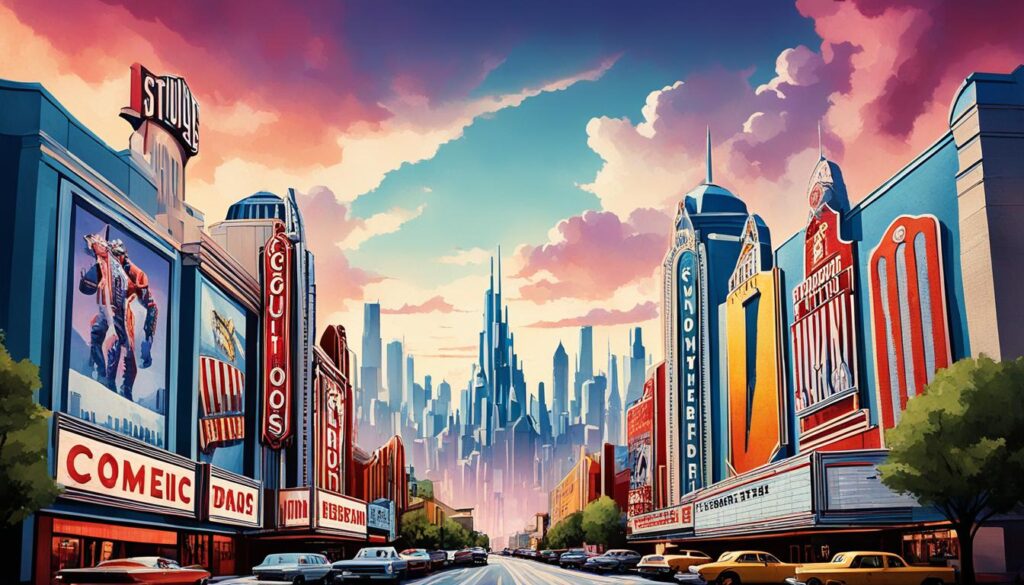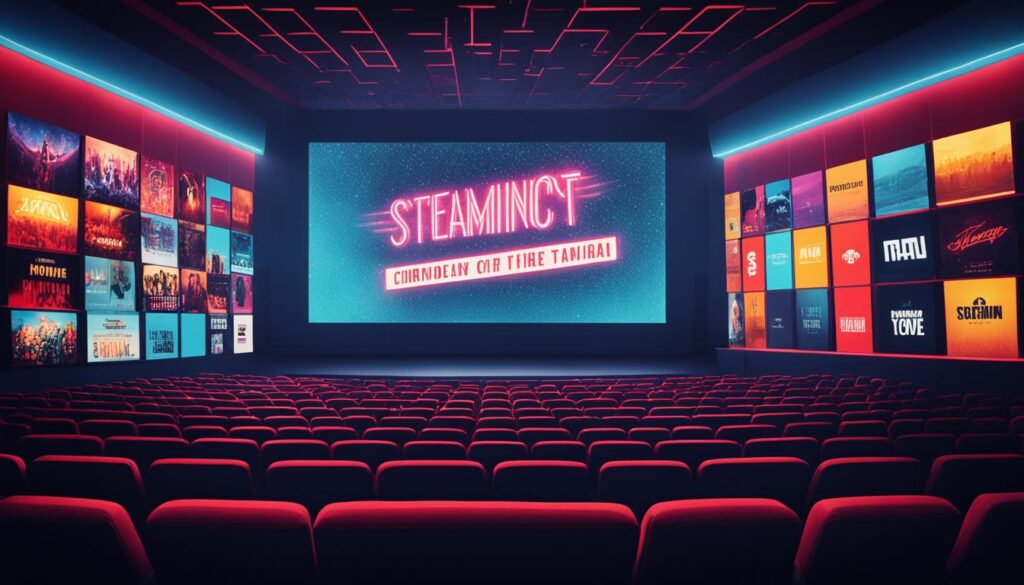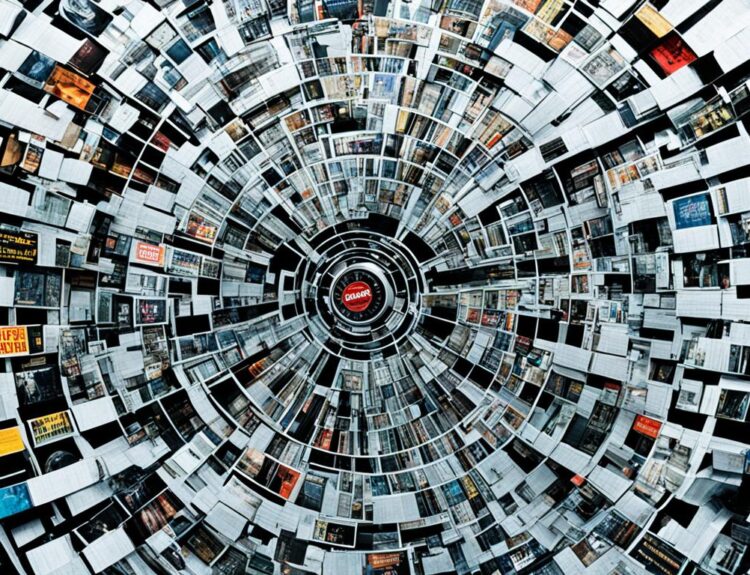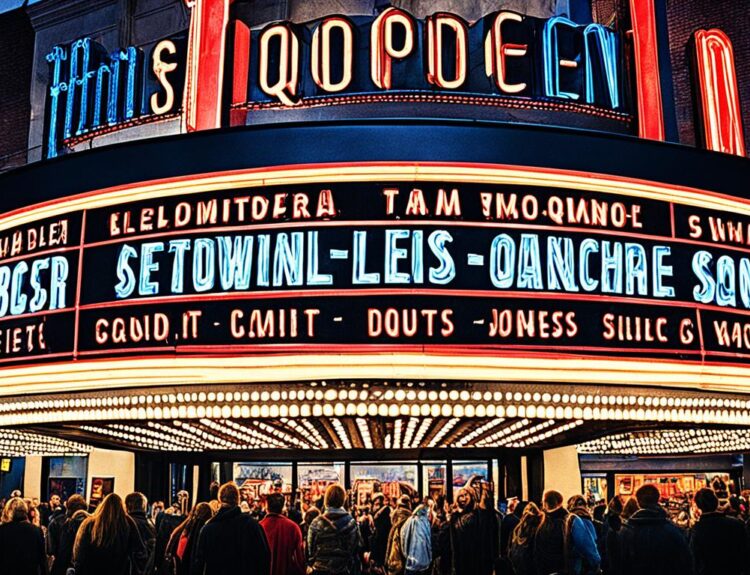Watching movies in theaters is like finding a special place for fun and self-reflection, even with today’s big changes. With the rise of Netflix, Amazon Prime Video, and Disney+, how we watch films is changing. This means theaters are facing tough competition1.
New tech, like virtual reality and 3D, is changing how stories are told and making movies more exciting for us. As people get more interested in these cool experiences, theaters need to offer new things to keep us coming back1.
The variety of movies being made is helping to pull people away from their couches. Theaters that show different kinds of stories and represent more groups can attract a bigger crowd. This helps bring support for many types of movies.
To stay in the game, theaters are adding cool stuff like fancy seats and meals right to your seat21. They also need to think about the planet and how to run things in a way that’s good for the earth. This is important as the movie industry grows and changes2.
Key Takeaways
- Streaming platforms are reshaping theatrical distribution and increasing competition for theaters.
- Technological advancements in VR and 3D are enhancing the moviegoing experience.
- Diversity in filmmaking can attract a more extensive audience base.
- Theaters are integrating premium amenities to differentiate from home viewing options.
- Sustainability practices are becoming crucial for the movie industry’s future.
The Evolution of Theatrical Distribution
Streaming services like Netflix, Amazon Prime Video, and Disney+1 are changing how movies reach us. Now, film studios think twice before only releasing movies in theaters. This is because a lot of us would rather watch new movies at home1. This trend particularly helps big blockbusters but is less favorable for smaller films1.
Also, movies are now available to rent at home soon after their theater run. This changes how long they stay exclusive to theaters1.
The Impact of Streaming Platforms
Streaming services are pulling more viewers their way. As movie making and marketing costs rise, smaller films find it harder to get into theaters1. But, tech like virtual reality might make movie theaters a unique experience, different from watching at home13.
Hybrid Release Models
The move towards hybrid release models marks a big change. It lets movies come out in theaters and on streaming at the same time1. This serves both movie-goers and those who prefer watching at home. Especially younger folks lean more towards streaming1.
Such changes make the window for theater-only viewing shorter. It shows we need flexible ways to release movies.
Also, there’s more investment in digital movie making and features like 3D4. These improvements give theaters an edge over the rising tide of streaming services.
Technological Advancements in Filmmaking
In recent years, filmmaking has seen great innovations. New tech, like virtual reality (VR) and augmented reality (AR), is changing how we enjoy movies. These offer an immersive and unique experience for viewers.
Virtual Reality and Augmented Reality
VR and AR are making movie watching different from just sitting at home56. They let the audience become part of the story, for a more interactive feel. Tools like Frame.io and Vimeo help filmmakers work together from afar5. And with streaming platforms, people can watch movies whenever they want, on any device5.
3D and 4DX Innovations
3D movies, like ‘Avatar,’ have shown how much they can add to storytelling. 4DX goes further by adding things like motion, wind, and smells. This creates a whole-body experience, attracting more people to theaters. These technologies are now key in making movies more exciting and visually stunning.
Advances in camera tech, like RED and ARRI Alexa cameras, have improved how movies look since the late noughties5. When combined with better sound tools like Pro Tools, movies have become more realistic and engaging5.
The film industry is evolving fast, thanks to these new tools. They’re changing what we expect from movies and offering filmmakers new ways to be creative.
Below is a comparative table highlighting some of these key innovations in filmmaking:
| Technology | Impact on Filmmaking |
|---|---|
| Virtual Reality (VR) | Enhances immersive storytelling, making viewers active participants in the narrative56. |
| Augmented Reality (AR) | Blends real and fictional worlds, transforming ordinary viewing into interactive experiences56. |
| 3D Cinema | Provides a depth-defying visual experience, heightening viewer engagement5. |
| 4DX | Incorporates sensory effects, such as motion and scent, for a comprehensive movie-watching experience5. |
Audience Behavior and Preferences
People are increasingly choosing to watch content at home for comfort and accessibility. Now, 48% of adults would rather have movies released on streaming services. They want to enjoy films at home. Plus, 60% see streaming as a way to save money7.
The Shift Towards Home Viewing
Viewers’ habits are changing, especially regarding cinema releases. Over half (51%) feel that movies going quickly to streams lessen the cinema’s allure7. This change means the industry must adapt to meet the convenience home viewing offers.
Younger Generations and Their Viewing Habits
The youth prefer streaming on-demand, challenging cinemas aiming for their business. They rather watch on devices like phones. Also, young groups without kids, called Fledglings and Nest Builders, do go to cinemas but aren’t the main audience7.
To stay relevant, cinemas must evolve with these trends. They need strategies and experiences that appeal to the young. Embracing new technology and unique features is crucial.
Film Marketing Strategies in a Digital Age
In today’s digital world, film marketing has changed to connect with audiences better. With 4.80 billion people using social media, platforms like Facebook and TikTok are key for promoting movies8. Given TikTok users spend about 10.85 minutes each time they use it, we see its value for sharing quick, engaging videos8. Also, with social media users expected to hit six billion in a few years, its impact on marketing keeps growing8.
Movie campaigns are now more interactive, using experiences to leave a lasting impression. Pixar’s “Inside Out” campaign is a great example, with its social media takeovers, online partnerships, and YouTube animations9. These digital tactics prove very effective in promoting films. The rising number of social media users shows the big potential of digital marketing for movies.
Louis C.K.’s “Live at the Beacon Theater” shows the benefits of selling directly to consumers online9. This approach cuts through traditional marketing hurdles and allows for quicker, more flexible promotion. Streaming services have changed how movies are shared, but TV is still important for big events, like sports8.
To sum up, successful film marketing mixes digital and classic methods. It uses social media’s wide reach and engaging experiences to grab attention. The growth in social media users and the continuing success of platforms like YouTube and TikTok show the need to keep up with digital trends89.
Box Office Performance Post-Pandemic
The movie world has really changed since the pandemic, showing big changes in both big movies and indie films.
The Rise and Fall of Blockbuster Releases
Big movies have seen ups and downs recently. In 2022, North American cinemas made $7.4 billion10. This was a strong comeback. But in 2023, while they made $9 billion, a 20% jump from 202211, it was still 21% less than the $11.4 billion in 201911. This shows a mixed bounce back for big movies.
In 2023, Warner Bros.’ “Barbie” did great, earning $636.2 million in the US and $1.44 billion worldwide11. Universal Studios beat Disney in the US, making about $1.94 billion in ticket sales11. Still, the industry is getting ready for a tough 2024, expecting to make between $7.5 billion and $8 billion11.
Indie and Arthouse Cinema Growth
Meanwhile, indie and arthouse movies are doing better, highlighting their success after the pandemic. Canada’s Cineplex had its third-best August in 2022, making $68 million, 120% of what they made in August 201910. Their box office and snack revenues for July and August 2022 were also 121% of the 2019 numbers10.
Globally, local movies are getting more love. Films from China, South Korea, and India are bringing in big crowds12. Hits like “Parasite” from South Korea and India’s “RRR” are winning fans worldwide, showing the power of local stories12.
This interest in different films is opening doors for smaller movies in the movie world. It shows a move away from just big blockbusters to a mix that includes indie successes. As we see more post-pandemic movie results, the industry stands at a turning point. It’s balancing big productions with the rise of indie success.
Global Cinema Trends
The global cinema scene is changing fast, thanks to China and India. These countries are becoming big in the movie world, changing the game for Hollywood. In 2022, India was at the top in making films, with about 2,500 movies. This was almost 29% of all movies made worldwide13. China also played a big role, making 6% of the world’s films that year13.
Hollywood now has to pay attention to what movie fans around the world like and want.
In 2023, the money made from movie tickets around the world jumped by 29.4%. It reached USD 33.2 billion13. The top hits were “Barbie,” “The Super Mario Bros. Movie,” and “Oppenheimer”13. This shows that people everywhere enjoy stories from different cultures. It makes them interested in international films and series14.
China and India’s Impact on Hollywood
Chinese movies are leaving a big mark on the global stage. So is Bollywood, with India making a huge number of films for the world. This is influencing what people want to watch and how movies perform globally1413.
Hollywood is starting to create more content that appeals to movie lovers from around the world. New technologies like 3D printing and real-time rendering are making it faster to make movies. This helps meet the demand in growing markets15.
Understanding the global cinema trends is key. Including the influence of Chinese and Indian cinema is vital for anyone wanting to succeed in the movie industry today.
| Country | Percentage of Global Film Production (2022) |
|---|---|
| India | 29% |
| China | 6% |
| USA | 10% |
| Japan | Third position |
Diversity and Representation in Cinema
In recent years, movies have been more inclusive. This change is important but not steady yet. For example, in 2023, 29.2% of main actors in movies were people of color. This number was an 8% jump from the year before16. Still, female directors were much less common than male directors, with a 3-to-1 ratio16.
People now prefer movies with diverse stories. This is clear from the success of films led by people of color. For 14 of the year’s top 20 movies, most of the first-weekend tickets were bought by them16. Also, for seven of the top 10 movies in 2023, BIPOC viewers were the main ticket buyers during the opening weekend17.
To increase diversity in movies, we need to look at more than just the actors. For instance, in movies, 22% of lead actors, but only 17% of directors and 12% of writers were people of color18. It shows the need for diverse storytellers, not just diverse stories.
Movies by BIPOC directors with diverse casts were 88% successful in showing diversity17. This shows that movies made inclusively tell more real and different stories. Yet, actors with disabilities are still rarely seen. They make up only 7.1% of actors in movies and streaming, much less than their 26% share in the population16.
| Category | Percentage |
|---|---|
| Lead Actors (People of Color) | 29.2% |
| Directors (People of Color) | 17% |
| Writers (People of Color) | 12% |
| Actors (Disabilities) | 7.1% |
| Films with Diverse Casts (Streaming) | 64% |
| Films with Diverse Casts (Theatrical) | 57% |
Premium Theater Experiences
Theaters are stepping up to attract people away from watching movies at home. They’re focusing on top-quality cinema experiences that offer luxury and comfort. The value of the global theater market was at USD 69.78 billion in 2023. It’s expected to rise to USD 95.66 billion by 2029. This growth shows how much effort cinemas are putting into making their spaces more inviting1920. Big names like AMC Entertainment and The Walt Disney Company are working hard to make going to the movies better than ever with fancy perks.
New technology like IMAX and 4DX are helping theaters become more appealing. But what’s really making a difference are the high-end features. Think luxury seats that recline and the option to have gourmet meals brought right to you19. These extra comfortable touches are what theaters need to draw in people who want something special.
Luxury Recliners and In-Seat Dining
What makes a theater experience premium? It’s all about luxury. Comfy recliners let you sink into relaxation while watching a film. Plus, having the option to enjoy fine food and drinks without leaving your seat is a big draw. This mix of indulgence and convenience is what sets theaters apart from just watching at home, attracting those looking for a premium service.
The trend towards these fancy amenities shows where the market is heading. Reports say focusing on these premium experiences is key for theaters wanting to stay in the game1920. It’s clear that people expect more now, which is pushing theaters to up their game.
The Future Role of Big Movie Studios
Big movie studios are facing new challenges in financing, production, and distribution. Their important role is changing but remains central to movie making. The arrival of streaming services like Netflix, with 200 million subscribers, and Disney+, which got 100 million in its first year, shows there’s stiff competition for cinemas15. This change is forcing studios to be more creative and innovative.
New technology is also shaking things up. Things like real-time rendering and 3D printing are changing how films are made15. Studios have to stay on top of these changes to keep leading the market. They also need to think about the environment. For instance, making an hour of TV can release 13 tonnes of CO₂15. Studios are now expected to find ways to lower their environmental impact.
In the U.S., a few movies make a big part of the box office money. In 2022, the top 10 films brought in 55% of the year’s total, up from 39% in 20192. This means studios have to focus on blockbusters but also offer a variety of films. Finding the right balance will be key for them as they move forward.

Challenges for Smaller Films
Independent films face tough challenges today. They struggle with high production costs and hard distribution paths. Without big studio money, getting their films to theaters is a steep climb.
The Rising Cost of Production
For small filmmakers, rising production costs are a huge barrier. Now, movies often need over $100 million for marketing and production21. This huge amount is hard for indie filmmakers to find. This makes it tough for their films to be seen.
“Pulp Fiction” made over $100 million, showing indie films can succeed. But, such hits are rare these days21. “Titanic” had a $200 million budget, showing the gap in resources between small and large projects21.
The Struggle for Theatrical Distribution
Independent films also face big distribution problems. Six major studios control 95% of the business, leaving little space for indies21. With blockbusters taking over, it’s hard for indie films to catch the audience’s eye. Yet, 60s and 70s French New Wave directors once inspired American filmmakers, even with distribution challenges21.
However, events like Sundance Film Festival offer some hope. They help indie films get noticed by bigger studios21.
Because of distribution challenges, indie films need to get creative Distribution hurdles mean using new marketing ways and social media. This helps them stand out and share their stories.
| Film | Opening Weekend Revenue | Production Cost |
|---|---|---|
| Pulp Fiction | $9.3 million | $8 million |
| Titanic | $28.6 million | $200 million |
| What Women Want | $33.6 million | $70 million |
| The Million Dollar Hotel | $29,483 | $8 million |
Innovative Approaches to Moviegoing
Cinemas are changing in big ways, bringing new tech to make watching movies cooler and more fun. These cool new changes make going to the movies a much bigger adventure than just watching a screen.
Interactive and Immersive Experiences
Interactive movies are becoming a huge thing, making you feel like you’re part of the story. You might find yourself in the middle of live action, amazing effects, or even being part of the show. This makes watching movies way more exciting than before.
Now, we also have super cool movie formats like Dolby, IMAX, and others that really bring the film to life2. They make everything look and sound so real, you feel like you’re right there in the action. It’s something you just can’t get from watching movies at home.
Last year, the top 10 movies in the US made up more than half the money earned at the box office2. This proves that people really love these new, fun movie experiences. They’re picking these awesome movies over the rest.
These new moviegoing options are also better for the planet2. They’re finding ways to be fun without harming the environment. So, cinemas are not just making movie-watching cooler but also helping our world.
Want to know more about what’s next for movies? Check out these exciting changes coming to cinemas soon.
Cinema Trends Shaping the Industry’s Future
The future of cinema is changing fast, thanks to key trends. Streaming giants like Netflix and Disney+ have huge audiences. They’re changing how we watch movies with their big number of subscribers and investment in new shows6. Also, blending different genres and telling stories in new ways are keeping viewers hooked6.
New tech like VR and AR is making movies more immersive than ever6. This pushes movie makers to be more creative, changing what audiences expect from films.
Independent filmmakers are making waves with powerful films on tight budgets. They’re telling unique stories that reach specific groups of people6. As the cinema industry grows, it shows there’s no one way to succeed. Being creative and open to change helps19.

Big cinema chains and companies will play a big role in these changes19. Working together with big names like Comcast and The Walt Disney Company will be important. It will help the industry grow in a good way, including everyone19.
The table below shows how big companies are investing and their role in the cinema world.
| Company | Investment in Original Content (2022) | Subscribers/Theater Presence |
|---|---|---|
| Netflix | $5.8 billion6 | 200 million subscribers6 |
| Disney+ | $10.5 billion6 | 100 million subscribers6 |
| Amazon Prime Video | $7 billion6 | NA |
| AMC Entertainment | NA | 900 theaters worldwide19 |
| Cinemark Holdings | NA | Strong presence in U.S. and Latin America19 |
| The Walt Disney Company | NA | Owns several theater chains19 |
| Comcast Corporation | NA | Owns various theater chains under NBCUniversal19 |
To stay successful, the cinema industry must be quick to change. Embracing new tech and ways to share movies is key. Focusing on what audiences want will help shape the future of movies and how we enjoy them.
The Persistent Issue of Movie Piracy
Movie piracy has been a big problem for the film industry, affecting how much money films make. The Internet has made movie piracy more common, causing even bigger problems worldwide22. With new technology, it’s gotten easier to find pirated movies, making it harder to fight piracy22. Sometimes, films and TV shows are released later in some places. This leads to more piracy as people don’t want to wait or hear spoilers22
To fight against stealing movies, movie studios are trying new things. One way is to show films early in theaters with a lot of security to stop people from recording22. They are also trying to release movies all over the world at the same time. This helps avoid leaks and reduce piracy22.
Streaming services offer a legal way to watch movies and shows right away. But, if people can’t afford to pay for many streaming services, they might go back to watching pirated movies22. Teaching people about piracy’s harm is key in this fight. With better security and new ideas, the industry hopes to lessen piracy and protect movies from being stolen.
For more information on movie piracy, check out articles like those at All The Right Movies. They give a full view of this ongoing problem.
Conclusion
The movie world is changing fast, thanks to new tech and different ways we watch films. Digital filmmaking helps directors be more creative and save money. They can play with images and lights in ways never before possible23. Sound quality is also getting better. This means we can lose ourselves completely in the movie’s world23.
Now, streaming sites like Netflix and Amazon Prime let more people see movies anytime. As of July 2023, Netflix had 238.39 million subscribers24. These platforms use special data to guess what movies will hit big, helping them spend their advertising money wisely23. Movies and shows are now made to appeal directly to certain groups, making sure everyone finds something they like23.
The film industry must keep up with these changes to stay fresh and enjoyable. Future plans need to mix the magic of theater movies with the ease of watching at home. Stories and characters that speak to big issues will keep drawing people in, pushing for change in the real world25. By holding onto the wonder of movie experiences while welcoming new ideas, the future of films looks bright and full of potential.
FAQ
How are streaming platforms impacting the theatrical distribution of films?
What are hybrid release models in the film industry?
How are technological advancements like virtual reality and augmented reality influencing filmmaking?
What innovations are enhancing the cinema experience through 3D and 4DX?
How is audience behavior shifting towards home viewing?
What are younger generations’ viewing habits when it comes to films?
How are film marketing strategies adapting to the digital age?
How has box office performance fluctuated post-pandemic?
How are China and India impacting Hollywood and global cinema trends?
Why is diversity and representation important in contemporary cinema?
What upgrades are theaters implementing to provide premium experiences?
What role will big movie studios play in the future cinema landscape?
What challenges are smaller films facing in the current movie industry?
What innovative approaches are being adopted to enhance the moviegoing experience?
What trends are shaping the future of the cinema industry?
How is movie piracy affecting the film industry?
Source Links
- https://nofilmschool.com/whats-future-cinema-and-theatrical-distribution
- https://tbco.medium.com/the-future-is-now-6-key-trends-that-will-transform-the-cinema-industry-in-2023-e9feec804e25
- https://en.wikipedia.org/wiki/History_of_film
- https://www.scienceandmediamuseum.org.uk/objects-and-stories/very-short-history-of-cinema
- https://www.falmouth.ac.uk/news/how-technology-has-changed-film-industry
- https://www.sae.edu/gbr/insights/top-trends-in-modern-film-production-navigating-the-future-of-filmmaking/
- https://www.kantar.com/uki/inspiration/advertising-media/consumer-cinema-trends
- https://www.gruvi.tv/post/movie-marketing/
- https://filmustage.com/blog/mastering-film-distribution-in-the-digital-era/
- https://www.visionmonday.com/business/research-and-stats/article/north-american-box-office-makes-post-pandemic-recovery/
- https://www.hollywoodreporter.com/movies/movie-news/barbenheimer-box-office-2023-revenue-bonanza-1235777081/
- https://hubstoria.com/the-global-box-office-rebound-post-pandemic-trends-and-the-future-of-international-cinema/
- https://www.wipo.int/global_innovation_index/en/gii-insights-blog/2024/global-cinema.html
- https://vitrina.ai/blog/global-cinema-trends-audience-preferences-guide/
- https://stageandcinema.com/2023/07/12/7-trends-reshape-the-future-film-industry/
- https://dailybruin.com/2024/03/26/2024-hollywood-diversity-report-shows-success-increase-in-racially-diverse-films
- https://www.forbes.com/sites/drdarnellhuntanddranachristinaramon/2024/03/07/diverse-audiences-prop-up-a-struggling-theatrical-industry-and-demand-diversity-on-screen/
- https://newsroom.ucla.edu/releases/hollywood-diversity-report-spring-2023-movie-industry
- https://medium.com/@narwatharsh01/global-theater-industry-trends-players-and-future-projections-88d0037abb8b
- https://www.linkedin.com/pulse/theater-market-trends-2024-harsh-narwat-jvvuc
- https://open.lib.umn.edu/mediaandculture/chapter/8-4-issues-and-trends-in-film/
- https://www.alltherightmovies.com/feature/the-internet-and-the-rise-of-movie-piracy/
- https://www.quantzig.com/blog/4-media-trends-film-industry
- https://filmustage.com/blog/unfolding-the-future-of-film-technology-key-trends-to-watch
- https://www.linkedin.com/pulse/impact-cinema-society-inspiring-change-shaping-culture





